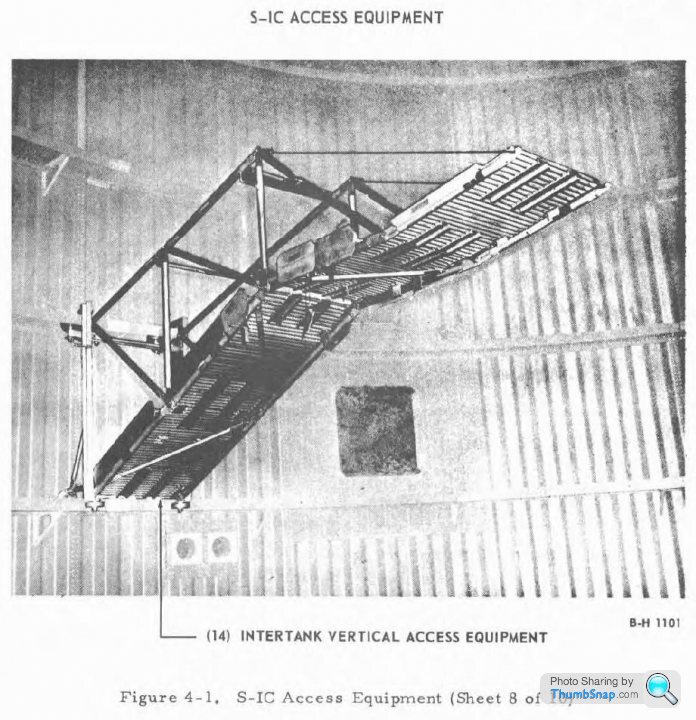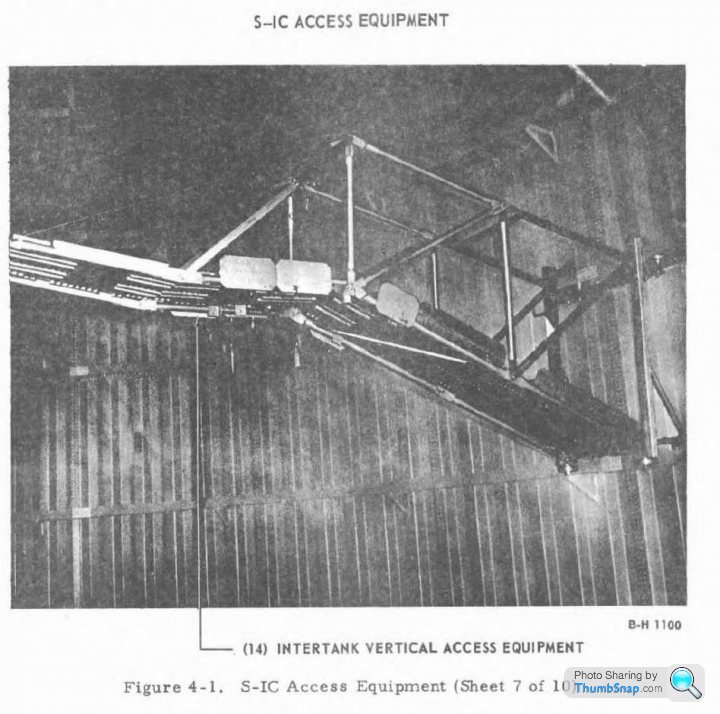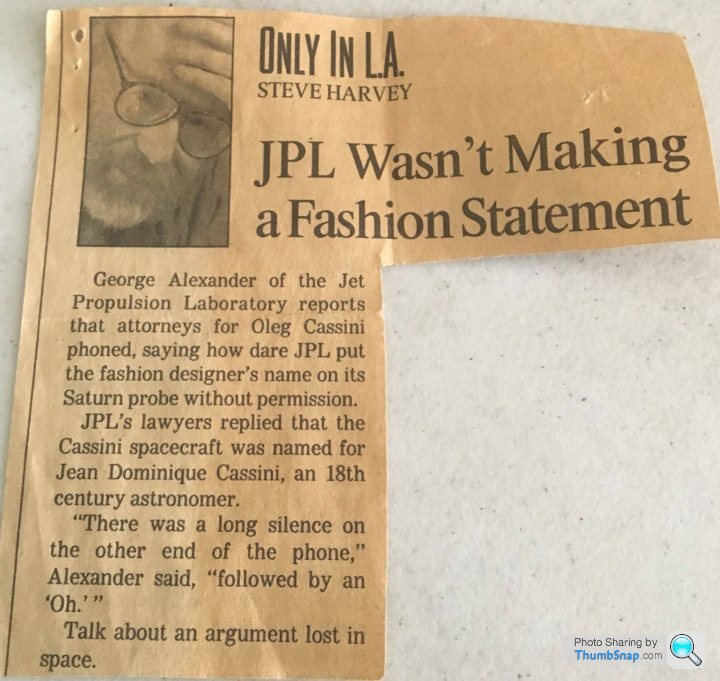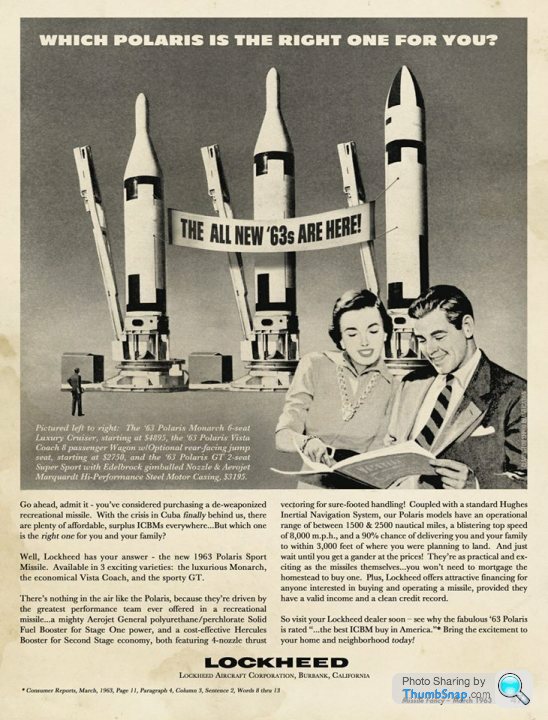Saturn V anecdote
Discussion
09/26/2002: A view of the camera mounted on the external tank of Space Shuttle Atlantis. The color video camera mounted to the top of Atlantis' external tank will provide a view of the front and belly of the orbiter and a portion of the solid rocket boosters (SRBs) and external tank during the launch of Atlantis on mission STS-112. It will offer the STS-112 team an opportunity to monitor the shuttle's performance from a new angle. The camera will be turned on fifteen minutes prior to launch and will show the orbiter and solid rocket boosters on the launch pad. The video will be downlinked from the external tank during flight to several NASA data-receiving sites and then relayed to the live television broadcast. The camera is expected to operate for about 15 minutes following liftoff. At liftoff, viewers will see the shuttle clearing the launch tower and, at two minutes after liftoff, see the right SRB separate from the external tank. When the external tank separates from Atlantis about eight minutes into the flight, the camera is expected to continue its live feed for about six more minutes although NASA may be unable to pick up the camera's signal because the tank may have moved out of range.
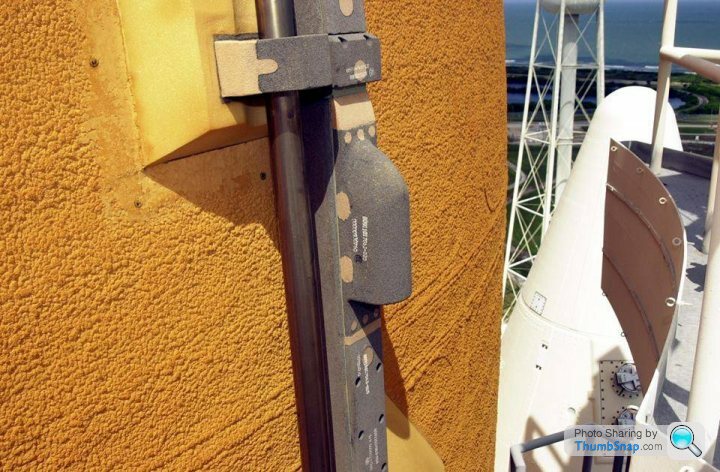

On the subject of Shuttles, here's a how much the top of the stack deflected when spooling up the 3 (off center) main engines. Once it "twanged" back, they lit the SRBs and released it.
https://www.youtube.com/watch?v=xmLeGBIj6kw
And here's a nice video of the Shuttle Atlantis pulling a full backward flip (in 4x speed) below the ISS:
https://www.youtube.com/watch?v=yBFMNVfmsEU
This was so the tiles could be photographed in hi-res and the pictures compared to ones taken earlier when it had been hung vertically in the VAB.
https://www.youtube.com/watch?v=xmLeGBIj6kw
And here's a nice video of the Shuttle Atlantis pulling a full backward flip (in 4x speed) below the ISS:
https://www.youtube.com/watch?v=yBFMNVfmsEU
This was so the tiles could be photographed in hi-res and the pictures compared to ones taken earlier when it had been hung vertically in the VAB.
From J Harvey LeBlanc
"The day I scared the seagulls at Launch Pad 39----- During one of the early Saturn V CDDTs it was reported that a large amount of helium was being vented to the atmosphere from the LUT area. Post test inspection indicated that the helium was coming from the system I had designed for chilling the Thrust Chambers on the S-II Stage J-2 engines. I was directed to fly down to KSC to do some troubleshooting of my system ASAP. During my hardware and data review I found that the helium had come from a large relief valve (#3) which had opened and failed to reseat (See the very simplified schematic of the system). The system gets it helium supply from a 6,000 psi storage facility which has a total tank volume of 9,000 gallon. The helium pressure was reduced in my system by two series pressure regulators. The first (#1) drops the pressure from 6,000 psi to 3,200 psi and the second (#2) drops the pressure from 3,200 psi to 1,200 psi. In the event that regulator #2 failed open or partially open, relief valve #3 was set to relieve at approximately 1,440 psi to assure that the down stream systems were not pressurized to an unsafe level. The 1200 psi gas was normally routed through the S-II LH2 Heat Exchanger to chill the gas down to about -300 degrees before flowing through a shutoff valve (#5), then to the S-II Stage engines to chill-down the Thrust Chambers to the start requirements. Shutoff valve #5 was normally opened to start the flow then closed just prior to liftoff. My data review indicated that after the shutoff valve #5 was closed, the cold gas in the line between the Heat Exchanger and #5 valve started to warm up which of course caused the pressure to start increasing to the point that the big relief valve #3 opened then failed to close when the system pressure was back to 1,200 psi. This resulted in the continuous venting of about 3 million cubic feet of helium to the atmosphere around the LUT! The guys at KSC kidded me by saying all the seagulls in the area were screeching in high pitch voices!!!
It had been my experience that large 1 1/2” high pressure relief valves, like #3, were not always reliable on reseat pressures if they were caused to relieve by very slowly increasing the inlet pressure. Since this application had a very slow pressure rise due to thermal expansion, I eliminated the problem by adding a small 3/8” backpressure regulator (#4) in parallel to the big relief valve but set to relieve at about 50 psi lower. Slow thermal expansion would cause a slow rise in pressure which was relived by the new small backpressure regulator #4 and prevent the pressure from going high enough to cause the big relief valve #3 to open. In the event of a major failed open regulator #2, both #4 and then #3 would open to keep the system safe. We never had another problem with this system!
This is just a minor example of the type problems that a Pneumatic System Designer would face all the time!!!"
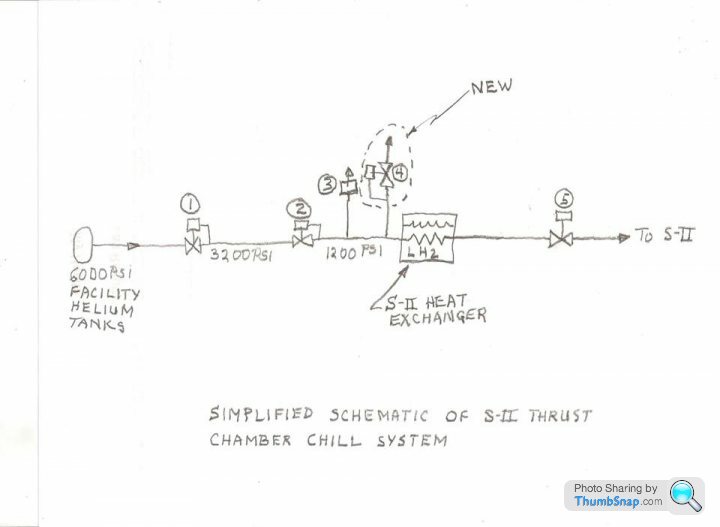
"The day I scared the seagulls at Launch Pad 39----- During one of the early Saturn V CDDTs it was reported that a large amount of helium was being vented to the atmosphere from the LUT area. Post test inspection indicated that the helium was coming from the system I had designed for chilling the Thrust Chambers on the S-II Stage J-2 engines. I was directed to fly down to KSC to do some troubleshooting of my system ASAP. During my hardware and data review I found that the helium had come from a large relief valve (#3) which had opened and failed to reseat (See the very simplified schematic of the system). The system gets it helium supply from a 6,000 psi storage facility which has a total tank volume of 9,000 gallon. The helium pressure was reduced in my system by two series pressure regulators. The first (#1) drops the pressure from 6,000 psi to 3,200 psi and the second (#2) drops the pressure from 3,200 psi to 1,200 psi. In the event that regulator #2 failed open or partially open, relief valve #3 was set to relieve at approximately 1,440 psi to assure that the down stream systems were not pressurized to an unsafe level. The 1200 psi gas was normally routed through the S-II LH2 Heat Exchanger to chill the gas down to about -300 degrees before flowing through a shutoff valve (#5), then to the S-II Stage engines to chill-down the Thrust Chambers to the start requirements. Shutoff valve #5 was normally opened to start the flow then closed just prior to liftoff. My data review indicated that after the shutoff valve #5 was closed, the cold gas in the line between the Heat Exchanger and #5 valve started to warm up which of course caused the pressure to start increasing to the point that the big relief valve #3 opened then failed to close when the system pressure was back to 1,200 psi. This resulted in the continuous venting of about 3 million cubic feet of helium to the atmosphere around the LUT! The guys at KSC kidded me by saying all the seagulls in the area were screeching in high pitch voices!!!
It had been my experience that large 1 1/2” high pressure relief valves, like #3, were not always reliable on reseat pressures if they were caused to relieve by very slowly increasing the inlet pressure. Since this application had a very slow pressure rise due to thermal expansion, I eliminated the problem by adding a small 3/8” backpressure regulator (#4) in parallel to the big relief valve but set to relieve at about 50 psi lower. Slow thermal expansion would cause a slow rise in pressure which was relived by the new small backpressure regulator #4 and prevent the pressure from going high enough to cause the big relief valve #3 to open. In the event of a major failed open regulator #2, both #4 and then #3 would open to keep the system safe. We never had another problem with this system!
This is just a minor example of the type problems that a Pneumatic System Designer would face all the time!!!"

Even the smallest things can cause problems in space...
From NASA engineer Dave Parker
"Hubble Space Telescope Power Control Unit, PCU, Main Bus C fastener that loosened due to thermal cycling on orbit and required PCU EVA replacement on Servicing Mission 3B by astronaut John Grunsfeld. When the old PCU was returned, my NASA program manager permitted me to open up the PCU and determine all of the failures. Based on telemetry, we suspected that this Fastener was at fault, and we were right. The fastener was too short to fully engage the nutplate locking feature, and it had been reused several times as witnessed by scarring of the torque-set in the head and worn, reduced diameter of the threaded tip. After removing the conformal coating around the fastener head, the washer under the head was free spinning. The loose joint in this bus resulted in an impedance fault causing batteries five and six to under charge. Since we knew this bus joint was implicated based on telemetry, we reworked and improved this joint in the replacement PCU before the Servicing Mission."
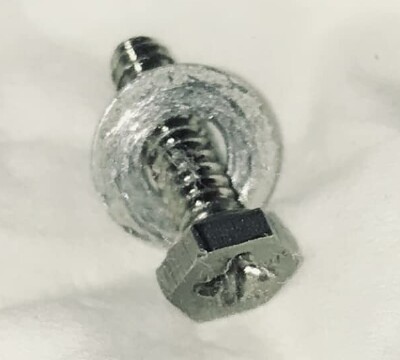

"This one fastener was holding together two lead-tin coated copper bus bars (PCU Main Bus C) carrying 1/3 of of all battery charge current for the Telescope. The loose joint prevented proper battery 5&6 charging. Battery 5&6 were chronically under-charged and reduced available battery capacity to support orbit night loads and potential safe mode events."
From NASA engineer Dave Parker
"Hubble Space Telescope Power Control Unit, PCU, Main Bus C fastener that loosened due to thermal cycling on orbit and required PCU EVA replacement on Servicing Mission 3B by astronaut John Grunsfeld. When the old PCU was returned, my NASA program manager permitted me to open up the PCU and determine all of the failures. Based on telemetry, we suspected that this Fastener was at fault, and we were right. The fastener was too short to fully engage the nutplate locking feature, and it had been reused several times as witnessed by scarring of the torque-set in the head and worn, reduced diameter of the threaded tip. After removing the conformal coating around the fastener head, the washer under the head was free spinning. The loose joint in this bus resulted in an impedance fault causing batteries five and six to under charge. Since we knew this bus joint was implicated based on telemetry, we reworked and improved this joint in the replacement PCU before the Servicing Mission."


"This one fastener was holding together two lead-tin coated copper bus bars (PCU Main Bus C) carrying 1/3 of of all battery charge current for the Telescope. The loose joint prevented proper battery 5&6 charging. Battery 5&6 were chronically under-charged and reduced available battery capacity to support orbit night loads and potential safe mode events."
From Chuck Waller
"I mentioned I once had to go on the launcher while the Saturn V, I think AS501, was fully fueled. Not normal, crews were kept a long way from the pad until the flight crew with their support were sent out after fueling. There was a small leak at a 1" connection about 15 ft. back on the LOX fll line on the side of swing arm 4. I knew this connection was going to leak as it had during 500F tests and no changes had been made to fittin. While I was in the firing room during the LOX fill of the S-II, the small leak was displayed on one of the large video screen there. I then got a call on headset from launch director to explain. Told him it was a boss type 1" male fitting with a teflon "O" ring. He then requested I that go to pad to check it out. I knew I could not fix it, but only tighten it down until I had a metal to metal seal which would still leak. Nobody asked me if I could fix it,, just get out there. I was not part of the Red Crew which was trained for pad work after fueling so I was surprised and nervous. Two swing arm techs. and a QC guy were sent with me. We were suited up and had anti static straps belted to anke. My feelings when we got to pad were much like explained in J.H. Ward's book Rocket Ranch". He says when the Red Crew had to go out it was "memorable". As he said "The strange and unearthly noises that dammed rocket made:creaking, groaning -- loud ssssss and some time sounding like a group of screaming banshees" All of this at night with the bright white light from the search lights. We hurried up the launcher out on arm 4 tightened the fitting and then got the hell out of Dodge. As far as I know that fitting leaked on every Saturn V launch. It was only a small dribble and would evaporate as it fell from arm 4."
"I mentioned I once had to go on the launcher while the Saturn V, I think AS501, was fully fueled. Not normal, crews were kept a long way from the pad until the flight crew with their support were sent out after fueling. There was a small leak at a 1" connection about 15 ft. back on the LOX fll line on the side of swing arm 4. I knew this connection was going to leak as it had during 500F tests and no changes had been made to fittin. While I was in the firing room during the LOX fill of the S-II, the small leak was displayed on one of the large video screen there. I then got a call on headset from launch director to explain. Told him it was a boss type 1" male fitting with a teflon "O" ring. He then requested I that go to pad to check it out. I knew I could not fix it, but only tighten it down until I had a metal to metal seal which would still leak. Nobody asked me if I could fix it,, just get out there. I was not part of the Red Crew which was trained for pad work after fueling so I was surprised and nervous. Two swing arm techs. and a QC guy were sent with me. We were suited up and had anti static straps belted to anke. My feelings when we got to pad were much like explained in J.H. Ward's book Rocket Ranch". He says when the Red Crew had to go out it was "memorable". As he said "The strange and unearthly noises that dammed rocket made:creaking, groaning -- loud ssssss and some time sounding like a group of screaming banshees" All of this at night with the bright white light from the search lights. We hurried up the launcher out on arm 4 tightened the fitting and then got the hell out of Dodge. As far as I know that fitting leaked on every Saturn V launch. It was only a small dribble and would evaporate as it fell from arm 4."
I thought Eric in particular would be interested in the following series of videos.
They're trying to resurrect an original Apollo Guidance Computer (AGC), which were built by Raytheon.
Part 1 is here:
https://www.youtube.com/watch?v=2KSahAoOLdU&li...
They're trying to resurrect an original Apollo Guidance Computer (AGC), which were built by Raytheon.
Part 1 is here:
https://www.youtube.com/watch?v=2KSahAoOLdU&li...
Not Saturn related, but maybe a tenuous connection via reverse engineering of old technology...
When new nuclear warheads were required in the mid 90s, engineers realised there was no need to re invent the wheel, and set about making replacements based on the older ones, made back in the 70s. One small problem: A vital component, used to hold parts of the explosive shell in place, was no longer made, the very name was classified, as were it's components (it was apparently like an aerogel substance, that turned to plasma as part of the detonation cycle) and none of the manufacturing data had been kept, as it was so classified all the info was destroyed once they had finished making the required amounts. (And the original teams had long been retired and many had passed away)
But hey, it's the 90s, they can reverse engineer it from the existing material still in warheads, right?
Years later, way past the deadlines and horrifically over budget, they still hadn't been able to replicate it perfectly enough for it to do what it was supposed to do. It turns out modern manufacturing was the problem, as modern cleaning techniques on the manufacturing gear was eliminating a contaminant that had unkowingly been there back in the 70s, which when introduced in the manufacturing process added just the right thing to the gunk.
Once they figured that out, they added the contaminant as an ingredient and could then actually make something that had been originally made almost 30 years before. Sometimes modern gear and a couple decades of knowledge don't give the results you expect.
When new nuclear warheads were required in the mid 90s, engineers realised there was no need to re invent the wheel, and set about making replacements based on the older ones, made back in the 70s. One small problem: A vital component, used to hold parts of the explosive shell in place, was no longer made, the very name was classified, as were it's components (it was apparently like an aerogel substance, that turned to plasma as part of the detonation cycle) and none of the manufacturing data had been kept, as it was so classified all the info was destroyed once they had finished making the required amounts. (And the original teams had long been retired and many had passed away)
But hey, it's the 90s, they can reverse engineer it from the existing material still in warheads, right?
Years later, way past the deadlines and horrifically over budget, they still hadn't been able to replicate it perfectly enough for it to do what it was supposed to do. It turns out modern manufacturing was the problem, as modern cleaning techniques on the manufacturing gear was eliminating a contaminant that had unkowingly been there back in the 70s, which when introduced in the manufacturing process added just the right thing to the gunk.
Once they figured that out, they added the contaminant as an ingredient and could then actually make something that had been originally made almost 30 years before. Sometimes modern gear and a couple decades of knowledge don't give the results you expect.
MartG said:
Not Saturn related, but maybe a tenuous connection via reverse engineering of old technology...
When new nuclear warheads were required in the mid 90s, engineers realised there was no need to re invent the wheel, and set about making replacements based on the older ones, made back in the 70s. One small problem: A vital component, used to hold parts of the explosive shell in place, was no longer made, the very name was classified, as were it's components (it was apparently like an aerogel substance, that turned to plasma as part of the detonation cycle) and none of the manufacturing data had been kept, as it was so classified all the info was destroyed once they had finished making the required amounts. (And the original teams had long been retired and many had passed away)
But hey, it's the 90s, they can reverse engineer it from the existing material still in warheads, right?
Years later, way past the deadlines and horrifically over budget, they still hadn't been able to replicate it perfectly enough for it to do what it was supposed to do. It turns out modern manufacturing was the problem, as modern cleaning techniques on the manufacturing gear was eliminating a contaminant that had unkowingly been there back in the 70s, which when introduced in the manufacturing process added just the right thing to the gunk.
Once they figured that out, they added the contaminant as an ingredient and could then actually make something that had been originally made almost 30 years before. Sometimes modern gear and a couple decades of knowledge don't give the results you expect.
Lol. We had something similar at work.When new nuclear warheads were required in the mid 90s, engineers realised there was no need to re invent the wheel, and set about making replacements based on the older ones, made back in the 70s. One small problem: A vital component, used to hold parts of the explosive shell in place, was no longer made, the very name was classified, as were it's components (it was apparently like an aerogel substance, that turned to plasma as part of the detonation cycle) and none of the manufacturing data had been kept, as it was so classified all the info was destroyed once they had finished making the required amounts. (And the original teams had long been retired and many had passed away)
But hey, it's the 90s, they can reverse engineer it from the existing material still in warheads, right?
Years later, way past the deadlines and horrifically over budget, they still hadn't been able to replicate it perfectly enough for it to do what it was supposed to do. It turns out modern manufacturing was the problem, as modern cleaning techniques on the manufacturing gear was eliminating a contaminant that had unkowingly been there back in the 70s, which when introduced in the manufacturing process added just the right thing to the gunk.
Once they figured that out, they added the contaminant as an ingredient and could then actually make something that had been originally made almost 30 years before. Sometimes modern gear and a couple decades of knowledge don't give the results you expect.
Our gas circulatory used to leak a tiny bit of oil into the reactor gas. Over the years we improved the maintenance such that the don't leak any oil now.
We then found that the carbon deposition on the fuel increased due to the reduction of sulphur in the coolant gas.
We now have to inject carbonyl sulphide to put back what wasn't meant to be there but was helping keep the fuel clean.
From Stephen Coester...
This tale just shows how stupid I was in my twenties. The LUT was on the pad. We had some question about one of the expansion joints on the hydrogen lines. By myself I went up on the zero level, climbed over the hand rail, shinnied down the vertical LH2 lines and crawled across the horizontal lines to inspect the joint. No safety, no harness, just me sixty feet above the bottom of the flame trench. But I did accomplish my inspection. And I was afraid of heights.
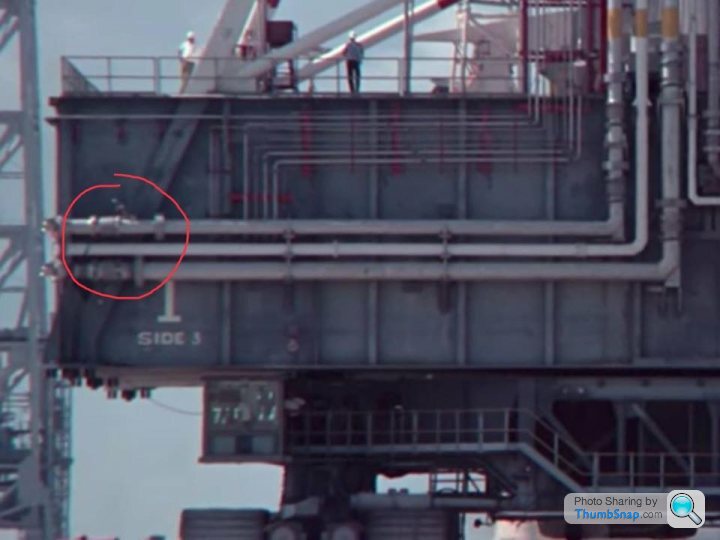
This tale just shows how stupid I was in my twenties. The LUT was on the pad. We had some question about one of the expansion joints on the hydrogen lines. By myself I went up on the zero level, climbed over the hand rail, shinnied down the vertical LH2 lines and crawled across the horizontal lines to inspect the joint. No safety, no harness, just me sixty feet above the bottom of the flame trench. But I did accomplish my inspection. And I was afraid of heights.

Beati Dogu said:
I thought Eric in particular would be interested in the following series of videos.
They're trying to resurrect an original Apollo Guidance Computer (AGC), which were built by Raytheon.
Part 1 is here:
https://www.youtube.com/watch?v=2KSahAoOLdU&li...
This has been overlooked! I found it randomly today and just came on here to post the link only to find it was posted months ago.They're trying to resurrect an original Apollo Guidance Computer (AGC), which were built by Raytheon.
Part 1 is here:
https://www.youtube.com/watch?v=2KSahAoOLdU&li...
This is highly recommended watching if you have an interest in the AGC in general, and even more so if you love electronics
With TASS reporting the death of space pioneer Valery Bykovksy, something rather bizarre has happened. The original six Vostok cosmonauts have passed away in the exact order they flew in space. Only the sixth and last, Valentina Tereshkova, now remains...
Gagarin (1968), Titov (2000), Nikolayev (2004), Popovich (2009), Bykovksy (2019), Tereshkova (living)
Gagarin (1968), Titov (2000), Nikolayev (2004), Popovich (2009), Bykovksy (2019), Tereshkova (living)
Gassing Station | Science! | Top of Page | What's New | My Stuff




